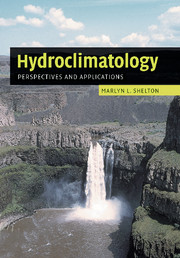Book contents
- Frontmatter
- Contents
- Preface
- 1 The realm of hydroclimatology
- 2 The climate system and the hydrologic cycle
- 3 Measuring hydroclimate atmospheric components
- 4 Measuring hydroclimate terrestrial components
- 5 Remote sensing and hydroclimate data
- 6 The runoff process and streamflow
- 7 Hydroclimate spatial variations
- 8 Hydroclimate temporal variations
- 9 Floods: the hydroclimatic extreme of excessive moisture
- 10 Drought: the hydroclimatic extreme of deficient moisture
- References
- Index
5 - Remote sensing and hydroclimate data
Published online by Cambridge University Press: 06 July 2010
- Frontmatter
- Contents
- Preface
- 1 The realm of hydroclimatology
- 2 The climate system and the hydrologic cycle
- 3 Measuring hydroclimate atmospheric components
- 4 Measuring hydroclimate terrestrial components
- 5 Remote sensing and hydroclimate data
- 6 The runoff process and streamflow
- 7 Hydroclimate spatial variations
- 8 Hydroclimate temporal variations
- 9 Floods: the hydroclimatic extreme of excessive moisture
- 10 Drought: the hydroclimatic extreme of deficient moisture
- References
- Index
Summary
Remote sensing data
Technology has provided an expanding array of alternative approaches for acquiring hydroclimatic data using instruments at a distance from the location being measured. The practice of distant measurement known as remote sensing is accomplished using instruments on satellites, aircraft, or the ground. In most cases, the remote sensing technique involves the interaction of electromagnetic radiation with the Earth's surface or the atmosphere. Aerial photography utilizing visible wavelengths of the electromagnetic spectrum was the earliest use of remote sensing (Engman, 1993). A wider array of the electromagnetic spectrum is utilized currently by multispectral scanners, thermal sensors, microwave sensors, lasers, radar (radio detection and ranging), and lidar (light detection and ranging) to measure or infer the fluxes of energy, precipitation, and evapotranspiration and to infer soil moisture and runoff over an area. In addition, sodar (sound detection and ranging) uses short sound pulses to determine wind characteristics.
Radar, lidar, and sodar are active remote sensors in that they emit a pulse of electromagnetic or acoustic radiation to probe the atmosphere and surface characteristics. They detect with a receiver a portion of the radiation that is reflected or backscattered by the target (Angevine et al., 2003). Passive sensors detect radiation emitted from the Earth's surface or from the atmosphere. A radiometer is a passive instrument that measures the emitted radiation in a specific region of the electromagnetic spectrum.
- Type
- Chapter
- Information
- HydroclimatologyPerspectives and Applications, pp. 126 - 164Publisher: Cambridge University PressPrint publication year: 2008



